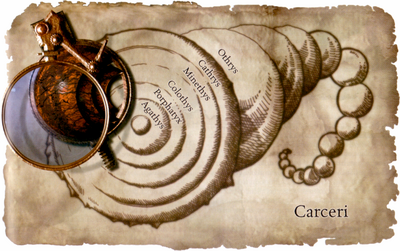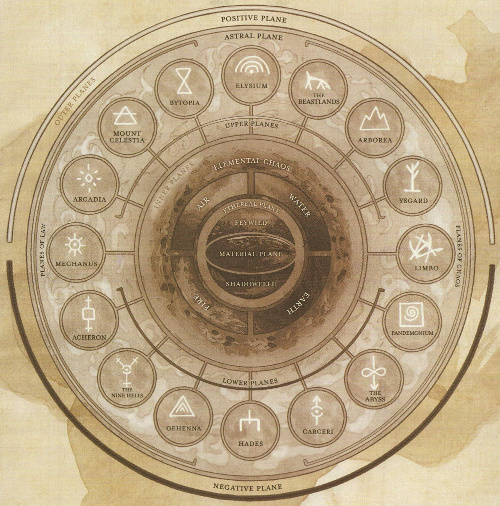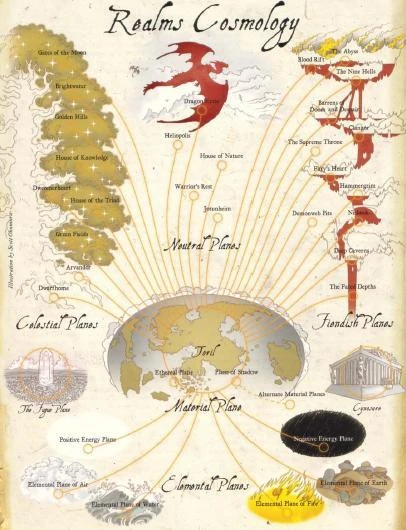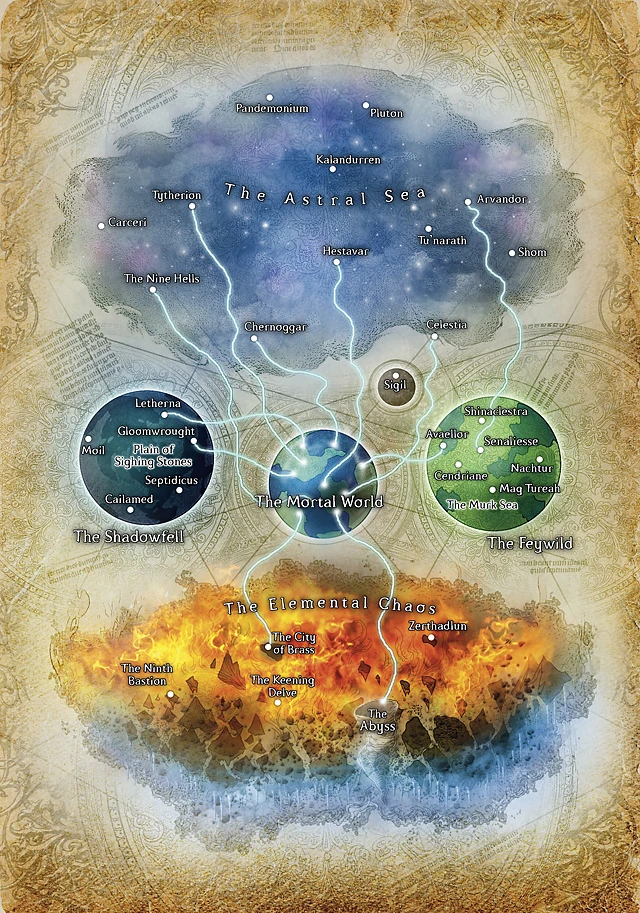The Tarterian Depths of Carceri (pronounced: /kɑːrˈsɛri/ car-SEHR-ee[15]) , also known as Tarterus,[16] was an Outer Plane in the Great Wheel cosmology model representing alignments between chaotic evil and neutral evil.[8][17] Situated between Hades and the Abyss, Tarterus was a plane of contention between the warring demons and devils but few of those interlopers would challenge the native demodands.[1]
Description[]
The six layers of Tarterus had a seemingly infinite number of worlds arranged like a string of pearls stretching into the air-filled void. In the top layer, Othrys, each orb was about the size of a Prime Material world and averaged about 100 miles (160 kilometers) from the nearest orb. In each successive lower layer the planetoids grew smaller and farther apart. There was no sun but the soil of each orb gave off heat and a dull reddish glow, similar to the phosphorescence of fire beetles. The planets did not rotate and there was no day or night unless a greater deity wished it so in their realm. Seasons and weather occurred randomly and what little plant life there was would rapidly mature after rainfall and then wither hours later.[11] Each orb was connected to one specific Prime Material world.[19]
The barriers between layers were always located at the deepest points on each planetoid and always lead to the same sphere in the next layer, so the worlds of Tarterus can be imagined as spheres nested like Matryoshka dolls and each layer contained a string of orbs of a particular size.[1]
Othrys[]

A representation of the layers of Carceri, according to the Great Wheel Cosmology. Hovering over the map will reveal main features. Clicking will link to the article for that location."
The first layer of Tarterus was named for Mount Othrys which was really two mountains on two adjacent orbs (both also called Othrys) each about 50 miles (80 kilometers) high joined together at the peaks in a massive citadel.[1] The worlds of Othrys were so close together that a traveler could easily fly from one to the next. For those who did not wish to fly, the river Styx flowed through all the worlds of this level in the usual mystical fashion. Many other rivers fed the Styx, and the surfaces of this layer were mostly marsh, bogs, and quicksand. Othrys was the brightest (due to the proximity of equal-sized worlds on either side) and warmest layer; no worse than a hot summer day on the Prime Material Plane. Other than the mountains, the ground was soft, like peat, and cut by deep chasms.[11] Othrys could be reached via the Astral Plane and had portals to the Abyss, Hades, and Concordant Opposition.[20] Long ago it could be reached via Mount Olympus, but when the Olympian gods overthrew the Titans they used their combined might to shatter the part of the mountain that connected to Tarterus, thus trapping the Titans on this plane.[21]
Cathrys[]
The planets of the second layer were smaller than those of Othrys and about 500 miles (800 kilometers) apart. Plant life in this layer was both abundant and deadly. The flora in the overgrown jungles and grasslands secreted acid that could eat through metal in a minute or less.[11]
Minethys[]
The third layer of Tarterus had planetoids smaller than those of Cathrys which hovered about 5,000 miles (8,000 kilometers) apart. The air between orbs was torn by harsh winds which carried poisonous dust storms from world to world, making most surfaces a barren desert. Huge tornadoes periodically swept through, carrying anything in its path to distant locations or even an adjacent orb.[11]
Colothys[]
The worlds of the fourth layer were spiked with colossal mountains rising above deep chasms. Hundreds of miles/kilometers from base to peak, the terrain of this layer made the orbs more asymmetrical than in other layers. Adjacent orbs were 500,000 miles (800,000 kilometers) apart so they appeared to be small spiky red moons in the utterly black sky. Legions of demons and daemons made lairs in the canyon walls.[11]
Porphatys[]
Black, acidic rain and snow assailed the many worldlets of the fifth layer from giant black clouds that moved between them.[11] On individual worlds, islands barely higher than sandbars came up over the waves of shallow, cold oceans.[22] The snow only stuck to the peaks of any mountains, melting to cover the rest of the surfaces with 1‒6 ft (30‒180 cm) of a weak acid that did not affect metal or stone but could eat away cloth in a minute or less.[11] All barriers between this layer and the next were under water.[1] The orbs of Porphatys were millions of miles/kilometers apart and barely discernible even when not blocked by demonic clouds.[11] A pilotless vessel called the Ship of One Hundred endlessly sails the seas of Porphatys.[22]
Agathys[]
The smallest, coldest planetoids occupied the sixth layer and were so far apart that neighboring orbs could not be seen at all. Every surface was covered in dark ice that showed streaks of red and the air was so cold it made breathing difficult.[11] If any layer existed beyond Agathys, the barriers would have been buried under miles/kilometers of ice.[1]
Inhabitants[]
The dominant race that inhabited Tarterus were the winged demodands.[1] Shators were the ruling nobility,[23] typically controlling major portions of an orb. All but the most powerful daemons and demons would avoid them.[1] Also found on this plane were nightmares, achaierai, and shadow demons,[1] with reports of mephits,[24] hordlings,[25] and vargouille.[26]
The Companions of the Hall entered Tarterus by means of the Taros Hoop.[27]
Realms[]
- Grolantor, god of the hill giants,[28] made his home among the peaks and chasms of Colothys[21] before moving to the World Tree cosmology plane of Jotunheim in a realm called The Steading.[29]
- Karontor, god of fomorians and verbeeg, resided here[30] in his realm, the Rack of Injustice, on Minethys.[31]
- Kiputytto, Goddess of Sickness and Mother of the Plague,[32] was a goddess of similar portfolio as Talona and was either an aspect of Talona[33] or was defeated by her in a battle over religious territory.[34]
- Malar the Beastlord had a realm in Tarterus[35][36] before he moved to the World Tree cosmology plane of Fury's Heart called the Land of the Hunt.[37]
- Null, draconic god of death, had a realm named the Mausoleum of Pain in his aspect of the Faluzure in Minethys, with some link to the Negative Energy plane, the Plane of Shadow and the Mausoleum of Chronepsis in the Outlands.[38]
- Parrafaire's realm Trickster's Delight resided in Minethys.[39]
- Talona, Lady of Poison and Mistress of Disease, resided on this plane[33][40] before moving to the World Tree cosmology plane of the Barrens of Doom and Despair in a realm called the Palace of Poison Tears.[41]
- Vhaeraun's realm, Ellaniath was located in Colothys[42][43] before he moved to the Demonweb Pits.[44]
- Zaltec's realm, Zompantli, the Place of Skulls, was is on Cathrys, the second layer of Carceri.[45]
Appendix[]
Appearances[]
Adventures
Novels & Short Stories
Video Games
Organized Play & Licensed Adventures
The Guns of Azzagrat: The Brigadier
References[]
- ↑ 1.0 1.1 1.2 1.3 1.4 1.5 1.6 1.7 1.8 Jeff Grubb (July 1987). Manual of the Planes 1st edition. (TSR), p. 104. ISBN 0880383992.
- ↑ Jeff Grubb (April 1987). “Plane Speaking: Tuning in to the Outer Planes”. In Roger E. Moore ed. Dragon #120 (TSR, Inc.), pp. 42–43.
- ↑ Jeff Grubb (July 1987). Manual of the Planes 1st edition. (TSR), p. 62. ISBN 0880383992.
- ↑ Jeff Grubb, Bruce R. Cordell, David Noonan (September 2001). Manual of the Planes 3rd edition. (Wizards of the Coast), p. 49. ISBN 0-7869-1850-8.
- ↑ Richard Baker, John Rogers, Robert J. Schwalb, James Wyatt (December 2008). Manual of the Planes 4th edition. (Wizards of the Coast), p. 16. ISBN 978-0-7869-5002-7.
- ↑ Mike Mearls, Jeremy Crawford, Christopher Perkins, James Wyatt (2014). Dungeon Master's Guide 5th edition. (Wizards of the Coast), p. 47. ISBN 978-0786965622.
- ↑ Christopher Perkins (March 2003). “Life's Bazaar”. In Chris Thomasson ed. Dungeon #97 (Paizo Publishing) (97)., p. 47.
- ↑ 8.0 8.1 Jeff Grubb (July 1987). Manual of the Planes 1st edition. (TSR), p. 73. ISBN 0880383992.
- ↑ Jeff Grubb (July 1987). Manual of the Planes 1st edition. (TSR), p. 75. ISBN 0880383992.
- ↑ Jeff Grubb (July 1987). Manual of the Planes 1st edition. (TSR), pp. 78–82. ISBN 0880383992.
- ↑ 11.0 11.1 11.2 11.3 11.4 11.5 11.6 11.7 11.8 11.9 Jeff Grubb (July 1987). Manual of the Planes 1st edition. (TSR), p. 103. ISBN 0880383992.
- ↑ R.A. Salvatore (November 2005). The Halfling's Gem. (Wizards of the Coast), pp. 273, 278, 279. ISBN 0-7869-3825-0.
- ↑ Jeff Grubb, Bruce R. Cordell, David Noonan (September 2001). Manual of the Planes 3rd edition. (Wizards of the Coast), pp. 104–108. ISBN 0-7869-1850-8.
- ↑ Richard Baker, John Rogers, Robert J. Schwalb, James Wyatt (December 2008). Manual of the Planes 4th edition. (Wizards of the Coast). ISBN 978-0-7869-5002-7.
- ↑ Colin McComb (July 1996). “The Chant of the War”. In Ray Vallese ed. Hellbound: The Blood War (TSR, Inc.), p. 7. ISBN 0-7869-0407-0.
- ↑ David "Zeb" Cook (1994). Planescape Campaign Setting, A DM Guide to the Planes. Edited by David Wise. (TSR, Inc), p. 56. ISBN 978-1560768340.
- ↑ Mike Mearls, Jeremy Crawford, Christopher Perkins, James Wyatt (2014). Dungeon Master's Guide 5th edition. (Wizards of the Coast), p. 58. ISBN 978-0786965622.
- ↑ Colin McComb (December 1995). “Liber Malevolentiae”. In Michele Carter ed. Planes of Conflict (TSR, Inc.), p. 6. ISBN 0-7869-0309-0.
- ↑ Jeff Grubb, Kate Novak (March 1991). Song of the Saurials. (TSR, Inc.), chap. 20, p. 300. ISBN 1-56076-060-5.
- ↑ Jeff Grubb (July 1987). Manual of the Planes 1st edition. (TSR), p. 74. ISBN 0880383992.
- ↑ 21.0 21.1 Jeff Grubb (July 1987). Manual of the Planes 1st edition. (TSR), p. 105. ISBN 0880383992.
- ↑ 22.0 22.1 Richard Baker, Joseph D. Carriker, Jr., Jennifer Clarke Wilkes (August 2005). Stormwrack. (Wizards of the Coast), p. 9. ISBN 07-8692-873-5.
- ↑ Gary Gygax (August 1983). Monster Manual II 1st edition. (TSR, Inc), p. 34. ISBN 0-88038-031-4.
- ↑ Don Turnbull (1981). Fiend Folio. (TSR Hobbies), p. 64. ISBN 0-9356-9621-0.
- ↑ Gary Gygax (August 1983). Monster Manual II 1st edition. (TSR, Inc), p. 75. ISBN 0-88038-031-4.
- ↑ Gary Gygax (August 1983). Monster Manual II 1st edition. (TSR, Inc), p. 123. ISBN 0-88038-031-4.
- ↑ R.A. Salvatore (November 2005). The Halfling's Gem. (Wizards of the Coast), p. 271. ISBN 0-7869-3825-0.
- ↑ James Ward, Robert J. Kuntz (August 1980). Deities & Demigods. Edited by Lawrence Schick. (TSR, Inc.), p. 108. ISBN 0-935696-22-9.
- ↑ Richard Baker, James Wyatt (March 2004). Player's Guide to Faerûn. (Wizards of the Coast), p. 160. ISBN 0-7869-3134-5.
- ↑ Carl Sargent (May 1992). Monster Mythology. (TSR, Inc), p. 79. ISBN 1-5607-6362-0.
- ↑ Colin McComb (October 1996). On Hallowed Ground. Edited by Ray Vallese. (TSR, Inc.), p. 175. ISBN 0-7869-0430-5.
- ↑ James Ward, Robert J. Kuntz (August 1980). Deities & Demigods. Edited by Lawrence Schick. (TSR, Inc.), p. 59. ISBN 0-935696-22-9.
- ↑ 33.0 33.1 Ed Greenwood, Jeff Grubb (August 1987). “Cyclopedia of the Realms”. In Karen S. Martin ed. Forgotten Realms Campaign Set (TSR, Inc.), p. 14. ISBN 0-88038-472-7.
- ↑ Colin McComb (October 1996). On Hallowed Ground. Edited by Ray Vallese. (TSR, Inc.), p. 182. ISBN 0-7869-0430-5.
- ↑ Ed Greenwood, Jeff Grubb (August 1987). “Cyclopedia of the Realms”. In Karen S. Martin ed. Forgotten Realms Campaign Set (TSR, Inc.), p. 12. ISBN 0-88038-472-7.
- ↑ Jeff Grubb and Ed Greenwood (1990). Forgotten Realms Adventures. (TSR, Inc), p. 24. ISBN 0-8803-8828-5.
- ↑ Richard Baker, James Wyatt (March 2004). Player's Guide to Faerûn. (Wizards of the Coast), p. 153. ISBN 0-7869-3134-5.
- ↑ Dale Donovan (January 1998). Cult of the Dragon. Edited by Julia Martin. (TSR, Inc.), p. 121. ISBN 0-7869-0709-6.
- ↑ Colin McComb (October 1996). On Hallowed Ground. Edited by Ray Vallese. (TSR, Inc.), p. 176. ISBN 0-7869-0430-5.
- ↑ Jeff Grubb and Ed Greenwood (1990). Forgotten Realms Adventures. (TSR, Inc), p. 31. ISBN 0-8803-8828-5.
- ↑ Richard Baker, James Wyatt (March 2004). Player's Guide to Faerûn. (Wizards of the Coast), p. 146. ISBN 0-7869-3134-5.
- ↑ Eric L. Boyd (November 1998). Demihuman Deities. Edited by Julia Martin. (TSR, Inc.), p. 36. ISBN 0-7869-1239-1.
- ↑ Colin McComb (October 1996). On Hallowed Ground. Edited by Ray Vallese. (TSR, Inc.), p. 100. ISBN 0-7869-0430-5.
- ↑ Richard Baker, James Wyatt (March 2004). Player's Guide to Faerûn. (Wizards of the Coast), p. 149. ISBN 0-7869-3134-5.
- ↑ Douglas Niles (August 1991). “Maztica Alive”. Maztica Campaign Set (TSR, Inc.), p. 50. ISBN 1-5607-6084-2.
Connections[]
| Othrys | Cathrys | Minethys | Colothys | Porphatys | Agathys |
| Mount Othrys | Feculence Palace of Poison Tears Steading |
Mausoleum of Pain Rack of Injustice Trickster's Delight |
Ellaniath Land of the Hunt |

Prime Material plane • Feywild • Shadowfell • Fugue Plane
Transitive Planes: Astral Plane • Ethereal plane
Inner Planes: Elemental Plane of Air • Elemental Plane of Water • Elemental Plane of Earth • Elemental Plane of Fire • Elemental Chaos
Para-Elemental Planes: Frostfell • Swamp of Oblivion • Fountains of Creation • Great Conflagration
Quasi-Elemental Planes: Lightning • Radiance • Minerals • Steam • Vacuum • Ash • Dust • Salt
Outlands: Sigil
Outer Planes: Arcadia • Mount Celestia • Bytopia • Elysium • Beastlands • Arborea • Ysgard • Limbo •
Pandemonium • Abyss (Layers) • Carceri • Hades • Gehenna • Nine Hells • Acheron • Mechanus
Energy planes: Positive Energy plane • Negative Energy plane
Planar Pathways: Infinite Staircase • Oceanus • Mount Olympus • Styx • Yggdrasil
Far Realm

Prime Material plane • Cynosure • Fugue Plane
Transitive Planes: Astral Plane • Ethereal plane • Plane of Shadow • Spirit World
Celestial Outer Planes: Arvandor • Brightwater • Dwarfhome • Dweomerheart • Gates of the Moon • Golden Hills • Green Fields • House of Knowledge • House of the Triad
Fiendish Outer Planes: Abyss (Layers) • Barrens of Doom and Despair • Blood Rift • Clangor • Deep Caverns • Demonweb Pits • Fated Depths • Fury's Heart • Hammergrim • Nine Hells • Nishrek • Supreme Throne
Neutral Outer Planes: Dragon Eyrie • Heliopolis • House of Nature • Jotunheim • Warrior's Rest
Inner Planes: Elemental Plane of Air • Elemental Plane of Earth • Elemental Plane of Fire • Elemental Plane of Water • Positive Energy plane • Negative Energy plane
Planar Pathways: Infinite Staircase • River of Blood • World Tree
Far Realm

Prime Material plane
Fundamental planes: Astral Sea • Elemental Chaos
Astral dominions: Arvandor • Banehold • Celestia • Cynosure • Deep Wilds • Demonweb Pits • Dismal Caverns • Dwarfhome • Eternal Sun • Fugue Plane • Gates of the Moon • Green Fields • House of Knowledge • Nine Hells • Nishrek • Supreme Throne • Towers of Night • Tu'narath • Warrior's Rest
Elemental realms: Abyss (Layers) • City of Brass • Cresting Spires • Fimbulwinter • Hidden Realm • Muspelheim • Root Hold • Sky Home • Steading • Thraotor • Undying Pyre • Zerthadlun
Parallel planes: Feywild • Shadowfell
Anomalous planes: Far Realm
